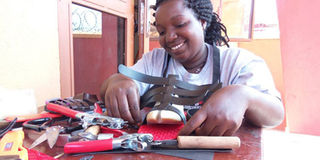Turn leather sandals into money-spinner

Ms Rosette Twizerimana, the founder and trainer at Tandika Uganda-a leathersandal training facility in Kyaliwajala-Namugongo teaches her students how to make sandals. PHOTO BY DOROTHY NAKAWEESI
What you need to know:
In only 10 days, you can learn how to make leather sandals. Dorothy Nakaweesi explains how lucrative this venture is and what you need to start.
Uganda’s trade imbalance will keep growing if the country continues importing almost everything including what can be made locally.
Industry watchers say if Uganda invests in producing locally and exporting these products, the trade balance will shrink as jobs will also be created for the growing population.
According to Uganda Investment Authority, this kind of investment can be done by any Ugandan in the diaspora looking to invest back home.
The leather sector has a lot of potential in terms of product and technology improvement and investment in value addition among others. If these are done, the potential to increase earnings and create employment is big.
Capital investment
Making and marketing leather sandals on a large scale requires starting capital of about $10,150 (Shs35.6 million). This kind of investment is premised on production of 18,200 leather sandals per month which translates into 218,400 sandals per year.
This means the revenue potential is estimated at $50,960 (Shs183 million) per month which translates into $611,520 (Shs2.2 billion) per year.
However, this does not mean that those with little capital cannot invest in this business. Mr Charles Ocici, the executive director Enterprise Uganda, shares: “This investment idea is very profitable and one can start with just $1,000 (Shs3.6 million).”
He adds that this will help in procuring some simple technology which is already available in Katwe and raw materials.
“The beauty with the raw materials is they are readily available locally and in the region,” he shares.
Production process
You can acquire skills in making the leather sandals at Tandika Uganda – a small scale training facility at Kyaliwajala-Namugongo. In just 10 days, you will be fully equipped with knowledge.
Ms Rosette Twizerimana, the founder of Tandika Uganda and the lead trainer, says that they mostly train women who can go back and start making the shoes within the comfort of their homes.
She says the 10-day training session costs Shs150,000 and one can start with capital of about Shs300,000 to Shs500,000.
She adds that they are in talks with the African Growth and Opportunity Act (AGOA) office to secure bigger market for some of their clients.
After the tannery process, different layers of skins and hides are put together to make shoe soles, another piece is cut to make the strings of the shoe.
The two pieces are then inter-joined using either glue or a sewing machine.
The two are finally taken for smoothening more especially at the edges.
Production costs assumed 312 days per year with a daily capacity of 800 leather sandals.
The shoes depreciate every four years with an asset write off of 25 per cent per year.
Direct costs include materials, supplies and other costs that go into producing the product.
Market
Mr Ocici says once you make up your mind to do this kind of business, invest in market research and brand your products.
He adds that for people who want to invest in this business, quality and elegance should be guaranteed with a target for the growing middle income class.
There is increasing demand for leather products processed from skins and hides.
Raw materials
Raw materials and equipment (skins and hides) can be got from Ankole and Karamoja regions in Uganda and equipment can be obtained from the local market.
Advice
Mr Ocici, however, says this business is associated with risks of stiff competition from other manufacturers, requiring you to use a unique strategy through price and place among others.
Incentives available
Since this kind of investment involves value addition, government is encouraging small scale businesses and income generating activities to eradicate poverty.
With support from the World Bank’s resource fund for skills development, funds can be accessed from Private Sector Foundation under the Skills Development Facility.




